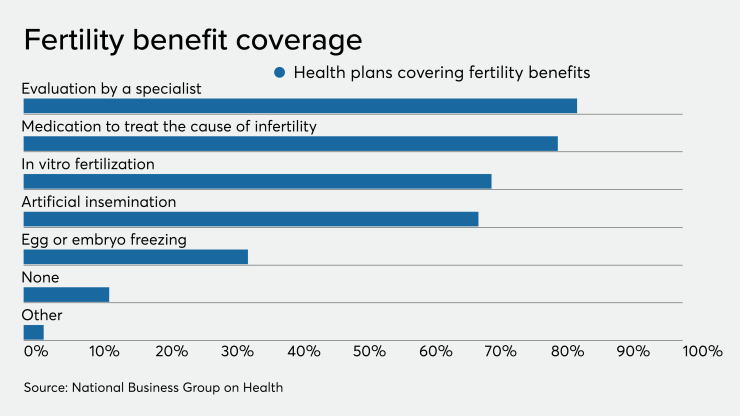Family planning benefits are in high demand among young workers and can give an employer a competitive edge in attracting top talent. But despite the growing demand, the majority of companies are lagging behind in their benefit offerings.
Just 18% offer in vitro fertilization support, and about 19% of employers offer fertility benefits other than IVF, according to data from the Society for Human Resource Management. Those figures declined from 26% and 24%, respectively, when compared to 2017. With the average cost of fertility treatments between $11,000 and $12,000, providing financial assistance can foster a culture of equality and fairness and lower health care costs, says Tammy Sun, CEO of Carrott Fertility.
“When we think about the kind of workplace we want to create and what we stand for, we want to work with employers who support employees who want to create equal access to how people are able to pursue parenthood,” Sun says.
Carrot Fertility is revamping their own benefits platform to ease the financial strain of paying for treatments with their latest program, Carrot Card. The debit card allows employees to use allocated funds to pay for approved services directly, so employees don’t have to reach into their own pockets.
Previously, employees would pay for their treatments — egg freezing, IVF, adoption donor and gestation services — and then be reimbursed through their employer via the Carrot platform.
Sun shared her thoughts on why providing financial assistance with fertility benefits is so crucial in a one-on-one interview.
Why should employers offer fertility benefits?
Our most motivated employer is one that is hearing from their employees. Employers and HR people in particular want to know how they can be of service. They want to know what is the best allocation of healthcare spending in a way that employees value and will have the highest impact. So the impact could be in that the ROI is measured through the reduction of medical costs related to unmanaged IVF. We also see that there is a high concentration of employees who use Carrot that are still with the company months later.
One of the biggest value propositions of flexibility in a fertility benefit is that opposite sex couples and LGBTQ+ people can have access to this kind of heathcare. There are a lot of aspects of LGBTQ+ healthcare that are excluded from the traditional healthcare system even outside of fertility.
HR and benefits have been struggling to figure out how to deal with this issue of equal access to fertility care, and they haven’t had asolution. There’s a very deep cultural aspect around equality and around fairness that comes up in these conversations at a very human level.
What do you think caused the drop in coverage SHRM reported?
The decline could be attributed to the fact that the insurance solution can be a little bit bumpy or that people who don’t have an infertility diagnosis can’t access coverage.
Increasingly, benefits leaders really want global solutions and insurance can’t offer that. So the decline may be attributed to the fact that there is just less utilization or less value being extracted from existing insurance solutions. We’ve seen very healthy adoption among our client base and we’re excited by the growth we’re seeing in both the fully insured employer group and the self funded employer group.
Why did you decide to launch Carrot card?
We really wanted to make it much more seamless to use Carrot. This is a new feature on our payments platform that does two things. First, the Carrot provider network is dynamically coded onto the card. That means the card can only be used at a Carrot approved care provider. The technology also has the employer’s custom plan design on the card. So that could be $5,000 of flexible fertility spending, $10,000, $20,000 etc. This way, the employee swipes and pays and it’s as easy as that. The employer has more data and insight into how the benefits are being tracked.
Before the Carrot card the only version of the product was through reimbursement and that means the employee pays for fertility care upfront. They use the app and we provide all of the features around adjudication, security and resiliency. Essentially the employee would be reimbursed through Carrot from the employer, but there are only some employees who can afford to do that.
We thought it was important that members could have a better experience. The employers could have more insights into the benefit and the ROI of the benefit, but also more people who can't afford to do reimbursements are getting access to fertility benefits.
Where is interest growing when it comes to offering fertility benefits?
We’re seeing a lot of interest in media and professional sports. We’re seeing continued interest from financial services consulting as well. It’s pretty diverse, as retail and manufacturing are coming online.
We’re continuing to respond to employer demand by bringing more countries into our roadmap. We are a global benefit and work with nearly 40 countries around the world. And we’re going to continue to double down on member features to make sure the member experience is as high quality as possible.






